From the large windows of the laboratory rooms at Habsburgerstrasse 49, one looks out onto the University of Freiburg's Botanical Gardens - or more precisely, its tropical greenhouse. An inspiring view for the researchers who work in modern laboratories and offices on four floors in this long building made of glass and exposed concrete. The sign at the door says "Hilde Mangold Haus," and next to it is an illustration of a young woman - Hilde Mangold, nee Pröscholdt. Celebrated, forgotten and rediscovered, her impressive research work continues to influence biology today.


Hilde Mangold
A pioneer in signalling research
This video presents the laboratory building of the University of Freiburg at the Habsburgerstr. 49 in Freiburg. It is the research building of the Cluster of Excellence CIBSS - Centre for Integrative Biological Signalling Studies - and is named after Hilde Mangold, co-discoverer of the famous embryonic “organizer” signalling center.
"By naming this building, we are honoring a young researcher with a pioneering spirit who has gone down in the history of biology and laid the foundations for signal research," says developmental biologist Wolfgang Driever, explaining the 2021 decision by the University of Freiburg and the Freiburg Cluster of Excellence CIBSS - Centre for Integrative Biological Signalling Studies to initiate the renaming. About a hundred years ago, Hilde Mangold made a discovery in Freiburg that would lay the groundwork for biological research in the decades that followed.
Embryology and Freiburg
The University of Freiburg has a long tradition in research into how a complex organism can develop from a single cell. In the laboratories of the Zoological Institute, August Weismann experimented on freshwater polyps and the eggs of sea urchins and newts until 1912 - work continued after the First World War by his successor Hans Spemann. With their observations, both researchers made fundamental contributions to the understanding of cell division, heredity and development.
Among the most central insights of this time were those of Hilde Mangold. As a doctoral student under Hans Spemann, she conducted research in Freiburg from 1920 to 1923. Her experiments on early-stage newt embryos were the first to show unequivocally that there is a center, the "organizer," in the embryo that controls the development of organs and tissues. Spemann was to receive the Nobel Prize for this discovery in 1935.
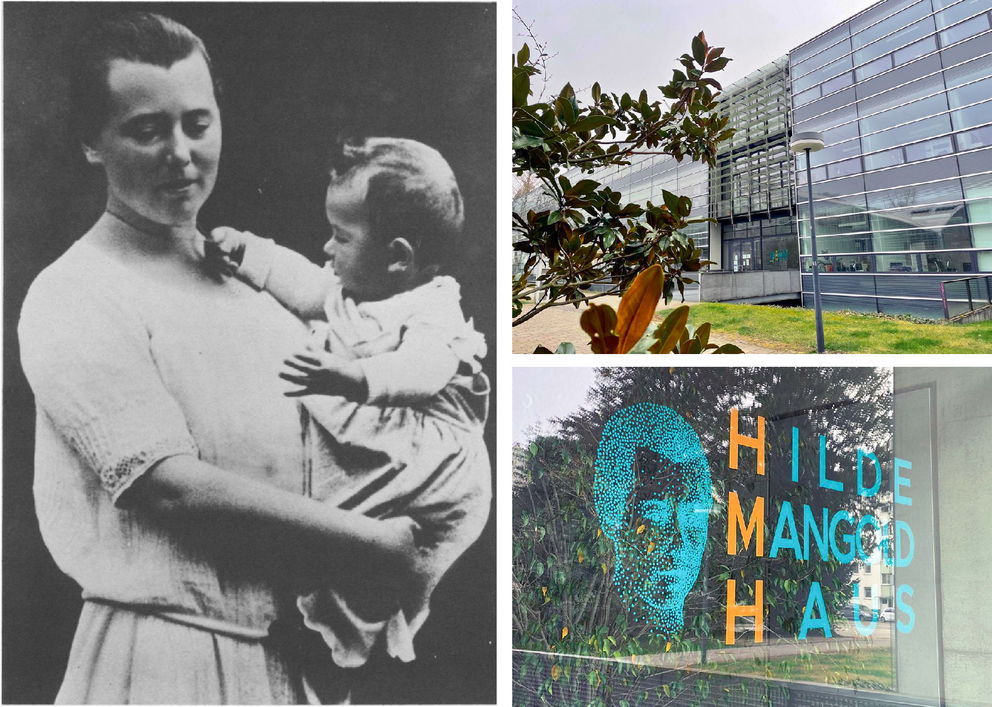
Left: Hilde Mangold, née Pröscholdt, with her son. Image: Viktor Hamburger. Hilde Mangold, co-discoverer of the organizer. Journal of the History of Biology (1984). doi: 10.1007/BF00397500
Right: The Hilde-Mangold-Haus in the Habsburgerstr. in Freiburg.
Hilde Mangold’s life in Freiburg
Spemann himself had come to Freiburg as head of the Zoological Institute only a short time before, when Hilde Pröscholdt, only 21 years old, began a doctorate with him. She moved to Freiburg in the spring of 1920 after hearing one of Spemann's lectures in Frankfurt and being fascinated by how he tried to unravel the mysteries of embryo development.
In Freiburg she also met the man who was to become her husband, Otto Mangold, and her colleague and friend Viktor Hamburger - both also students of Spemann. In 1984, Hamburger described his former colleague’s open and interested nature in the following words:
"By nature she was open, frank, and cheerful. She had a penetrating and reflective intellect and a lively sense of beauty in nature and in the arts. Like myself she had grown up in a small town, loved the outdoors, and was familiar with plant and animal life. But she was perhaps at her best in the endless discussions and debates with kindred minds that extended through long evenings in the open-air taverns at the square around the cathedral or in our small rooms. When we were in danger of taking ourselves too seriously, it was her sense of humor that saved the situation..."
From: Hilde Mangold, Co-Discoverer of the Organizer, Journal of the History of Biology 1984, Viktor Hamburger
Her studies as a doctoral student during this period were particularly free and extended beyond the boundaries of her subject. Hilde Mangold appreciated the thriving Freiburg art scene of the 1920s. Thus she cultivated a friendship with Julius Bissier, a Freiburg-born painter and important representative of the New Objectivity. It was he who created the memorial for Hilde Mangold's grave. She was also interested in philosophy, and listened to lectures such as Edmund Husserl's on phenomenology. The designation PhD - Philosophiae Doctor - was still taken seriously at that time.
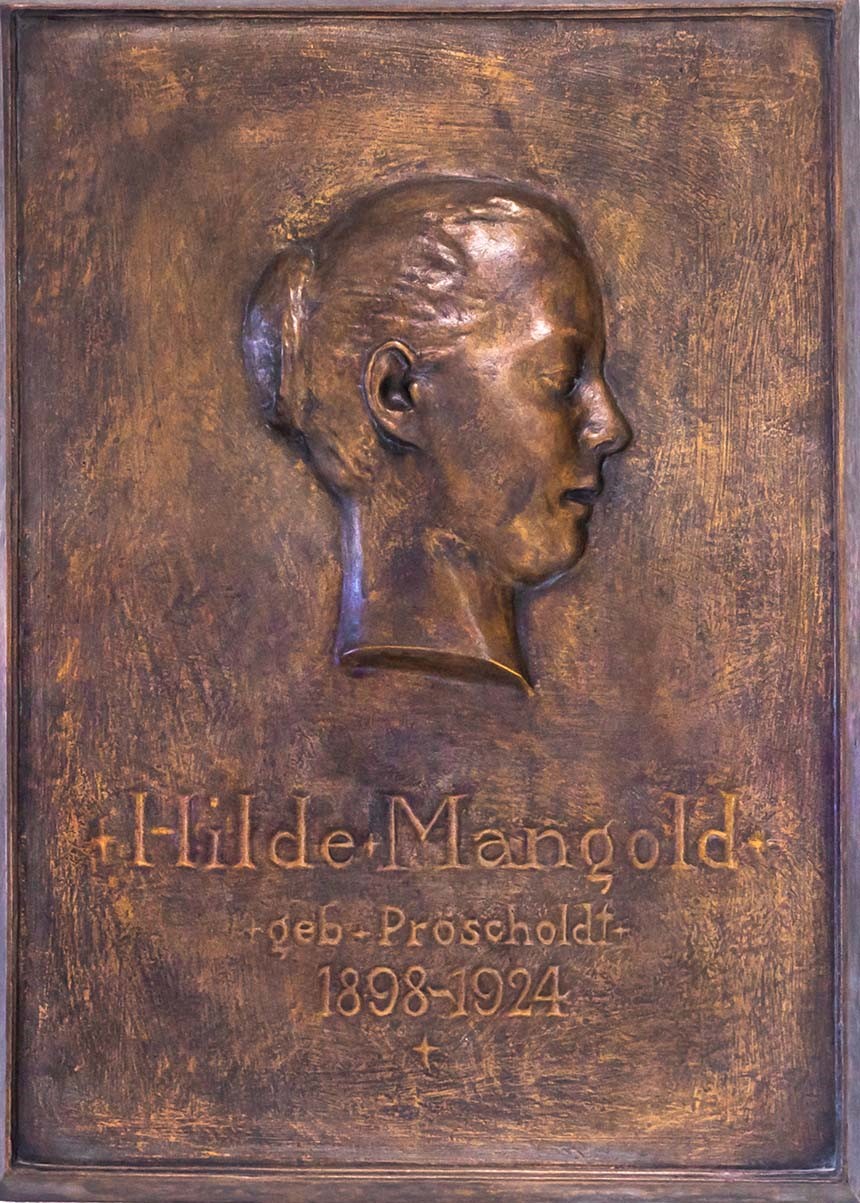
A cast of Hilde Mangold's gravestone hangs in the zoology building at the University of Freiburg.
Experiments leading to the Nobel Prize
Even before he came to Freiburg, Spemann was interested in when and how the position of later organs is determined during development. Decades before there was an understanding that biological processes rely on a complex interplay of signaling molecules and genes, he used microsurgical techniques to unravel the mysteries of developmental biology. For example, he had already observed that pieces of tissue transplanted to a different site in the embryo sometimes adapt to their new location, but sometimes form the organs of their place of origin.
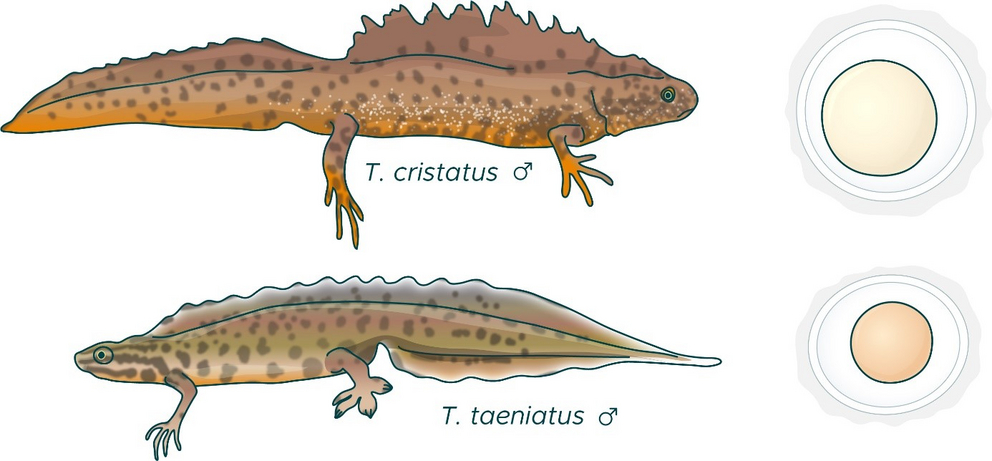
Spemann's experiments, in which he removed tiny pieces of tissue from embryos or swapped them between embryos, were conducted primarily on amphibians, especially newts. This is because their embryos are comparatively large and can be easily freed from the gelatinous shell in which thousands of them are deposited in bodies of water every spring.
Throughout 1920, Hilde Mangold learned from Spemann the techniques to mechanically manipulate newt embryos. The experimental approach that Spemann had developed was highly sophisticated. To cut out individual cells and tiny pieces of tissue from embryos under the microscope, he used fine, home-made pipettes made of glass and fine hairs from the head of his young daughter. Mangold quickly mastered these techniques, which require dexterity. After a first project that Spemann had assigned to Hilde Mangold did not work out, he assigned her an experiment that followed on from his earlier experiments. He had noticed that the blastopore, an inconspicuous structure in the early and otherwise still completely round new embryo, seemed to have special properties.
Spemann suspected that this tissue played an important role in the formation of the neural tube - the anatomical structure that forms very early in the embryo and from which the nervous system and spinal cord later develop. He had observed that intact tadpoles develop from divided embryos when part of the blastopore remains attached. If the blastopore is missing, no neural tube forms and a larva develops that lacks all the organs of the head and back. The experiment, which he assigned to Hilde Mangold, was meant to shed light on this observation.
In the early years of 1921 and 1922, Mangold transplanted pieces of tissue from the upper edge of the blastopore from embryos of the newt species T. cristatus into the opposite side of embryos of the species T. taeniatus.
developmental biology in the 1920s
That developmental biology was still in its infancy in the 1920s is shown by how labor-intensive Mangold's methods and experiments appear by today's standards. Many methods that are indispensable today had simply not yet been invented - for example, staining that could be used to mark and distinguish cells of different origins. In her experiments, Mangold used different newt species with different natural pigmentation - the northern crested newt Triturus taeniatus with dark cells and the pond newt Triturus cristatus with light cells. At that time, the generic name of both species was still Triton. Freiburg offered an ideal research location for the work with newts due to its location between the Black Forest and the water meadows of the upper Rhine, but the researchers were dependent on the natural reproductive rhythm of the newts and all work with the embryos had to take place during the newts’ spawning season in spring.

The transplantation experiment: Under the microscope, Mangold removed part of the blastopore lip of a crested newt embryo, which is only millimeters in size. To do this, she used a glass pipette with a tip that she had made long and fine over a Bunsen burner. She inserted the piece of tissue into a newt embryo of a different species, on the opposite side of its primordial mouth. The transplanted cells induced the formation of a secondary body axis: the developing larva had two sets of the organs of the back and nervous system.
In May 1921, to the great astonishment of the whole group, Mangold presented for the first time an embryo that had developed a second neural tube at the site where she had transplanted the blastopore. And not only that - the different natural coloration of the two newt species showed that the second neural tube was not just made up of the newly inserted cells: the piece of blastopore had induced other cells in the environment to form neural tube structures as well. Spemann and Mangold called this effect "induction" and referred to the blastopore as the "organizer".
Over the following year and after more than 250 attempts, she succeeded another 29 times. "Her success rate would certainly have been higher if sterile solutions and antibiotics had been part of scientific work back then. Without these, a large proportion of the embryos died shortly after transplantation," explains developmental biologist Wolfgang Driever. To document six of the 29 successfully-produced chimeras with two neural tubes, Mangold made drawings - photographs of microscopic observations were still too difficult to reproduce. Mangold and Spemann published the detailed drawings together in 1924, with Spemann's name in first place.
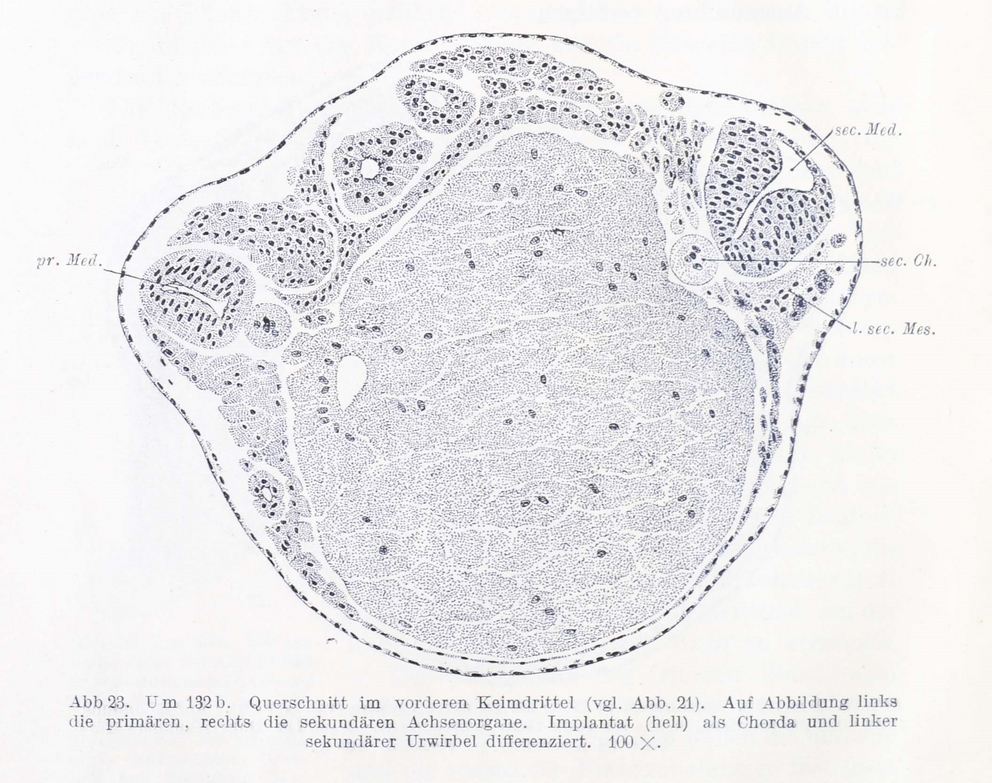
Cross-section through a newt embryo with induced structures on the right side. Image: Hans Spemann, Hilde Mangold. On induction of embryo structures by implantation of nonspecific organizers. Archiv für mikroskopische Anatomie und Entwicklungsmechanik (1924). Digitized by Freiburg University Library
Spemann and Mangold wondered how the transplanted piece of tissue, the organizer, could influence the surrounding cells. This question was the starting-point for the decades-long search for the active principle of induction in laboratories all over the world.
When Spemann received the Nobel Prize in 1935, the Nobel Prize Committee honored him primarily for the discovery of the organizer. Hilde Mangold did not live to see this triumph and recognition of her work, however, as she died of a household accident in 1924 after moving to Berlin with her husband Otto Mangold and their son. It is therefore not clear whether she would have received the Nobel Prize jointly with Spemann.
A woman in science
Over the course of the 20th century, a discussion arose about the woman Hilde Mangold, and it was only in recent years that the term "Spemann-Mangold organizer" replaced the previously more common "Spemann organizer". As a young researcher in the 1920s, Hilde Mangold was surrounded by patriarchal structures, and she was one of a few privileged women who had access to an academic career. At that time, one had to pay to do a doctoral thesis, and only the support of her parents, who had the means, allowed her to enter science.
It is no longer possible to say how much Hilde Mangold in her everyday life was confronted with the fact that she was one of only a few women to earn a doctorate at a university at that time. What is clear is that Spemann did not hesitate to accept her as a doctoral student. Mangold was not happy, however, that Spemann included his name on the publication of her doctoral thesis. Spemann had handled it differently with the other, male doctoral students. Viktor Hamburger explained Spemann's decision in retrospect by saying Spemann actually had a better appreciation of the relevance of the results. Later female members of the Spemann group, on the other hand, voiced criticism that Mangold had not been sufficiently honored for her discovery.
Spemann explicitly addressed Mangold's contribution in his Nobel lecture, but emphasized that her experiments were based on his suggestions. In fact, the consensus among historians today seems to be that Spemann's prior observations and planning of the experiments certainly entitled him to put his name first. Apart from Spemann's relative contribution, however, it was Mangold's practical skill and single-mindedness that made the experiments successful. She had to repeat the complicated and seemingly hopeless experiments hundreds of times until the organizer's function was clearly proven scientifically.
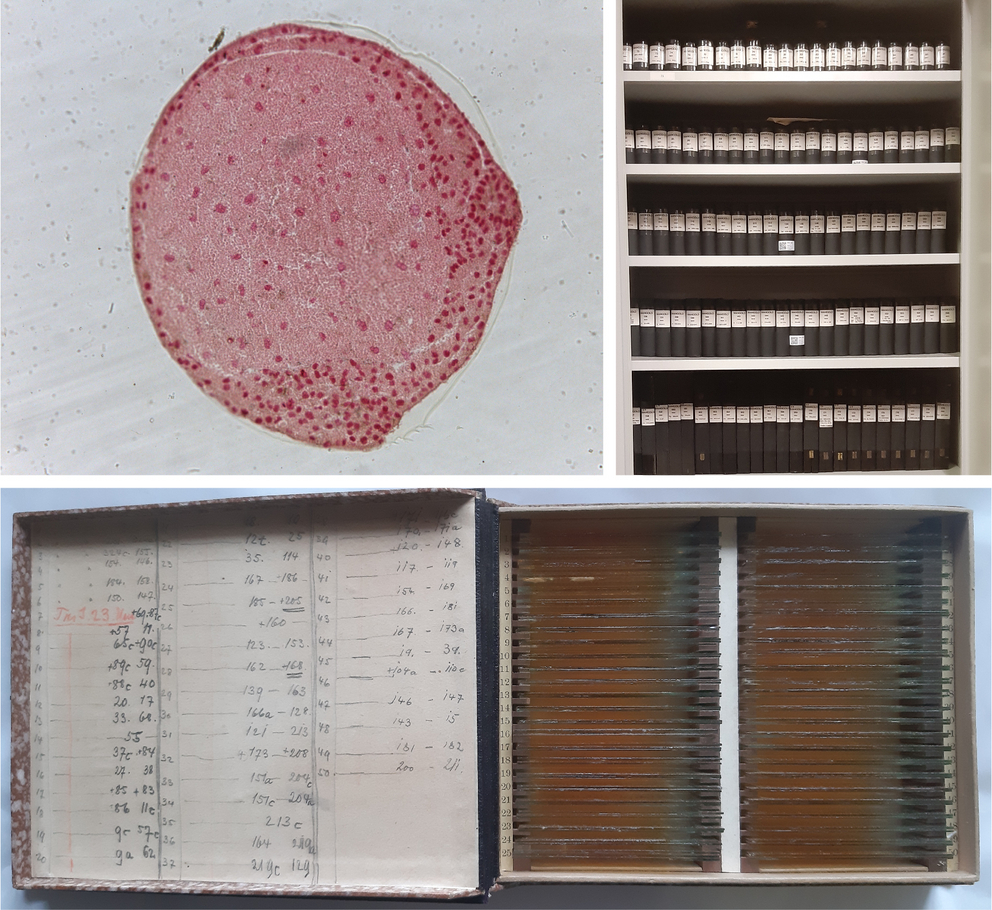
The original slides of Mangold's experiments have now been archived at the Berlin Museum of Natural History. Courtesy of the Museum für Naturkunde Berlin. Image: Museum für Naturkunde Berlin / Dr. Peter Giere
Her heritage
After the discovery of the organizer, scientists spent more than half a century trying to understand the "inducing principles" - which today we call biological signals. It was not until some 70 years after the publication of Mangold's doctoral thesis that researchers found the first signalling molecules of the Spemann-Mangold organizer. These signalling molecules were the bridge between new findings in molecular biology and the observations from Mangold's transplantation experiments. They showed that Spemann and Mangold were correct in their assumption that the organizer’s cells can influence the surrounding cells by an agent of some kind. The variety of molecular mechanisms by which the organizer controls important signals in the embryo has continued to surprise scientists to this day. After a hundred years, it is clear that Mangold's experiments were an important starting point for the study of biological signal transduction. They demonstrate how essential molecular signals are for the development and function of living organisms.
By Michal Rössler & Mathilde Bessert-Nettelbeck



